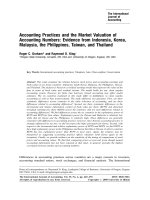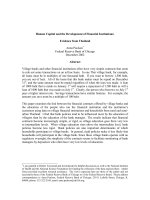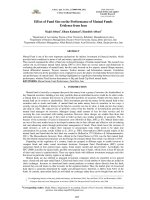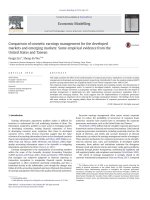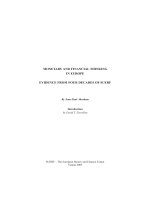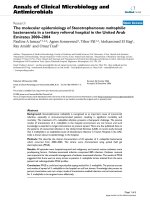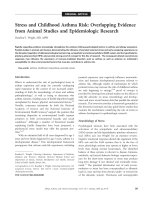The effect of managerial power and relational trust on the skills and traits of knowledge acquisition: Evidence from the United Arab Emirates
Bạn đang xem bản rút gọn của tài liệu. Xem và tải ngay bản đầy đủ của tài liệu tại đây (214.66 KB, 12 trang )
The effect of Managerial Power and Relational Trust on the
Skills and Traits of Knowledge Acquisition: Evidence from
the United Arab Emirates
John D. Politis
Higher Colleges of Technology, Dubai, United Arab Emirates
Abstract: Many organisations have recognised that knowledge is the most important resource in today’s economy. Although
knowledge management is seen as central to process and product innovation and improvement, to executive decision making
and to organisational adaptation and renewal, little is known on the effect of managerial power and relational trust on the traits
and skills of knowledge acquisition. A survey of 140 first line managers was conducted to investigate the relationship between
managerial power, relational trust and knowledge acquisition attributes. Results indicate that most, but not all, of the managerial
power dimensions enable employees’ knowledge acquisition. Moreover, the findings show that relational (interpersonal) trust
had a negative effect on the skills and traits of knowledge acquisition. It was also found that the dimensions of managerial
power provided statistically significant additional predictive power, after having statistically controlled for the predictive effects of
interpersonal trust.
Keywords: Knowledge acquisition ♦ managerial power ♦ relational (interpersonal) trust ♦ United Arab Emirates.
1. Introduction
st
As we have move rapidly into the 21 century
organisations face the challenge of being
effective in a global knowledge environment. In
his book PowerShift, Toffler (1990) made it
clear that knowledge has become the global
competitive driver. The real challenge for
organisations is “capturing the tacit knowledge
which is in people’s heads – the experience,
knowledge and judgement you get from doing
something for a long time,” says Stephanie
Pursley [1]. But actively managing (acquiring)
knowledge relies on individual’s effort and cooperation, so the new model of knowledge
management is about personal relevance
(Bailey & Clarke, 2001), it is about people and
actions and their behaviour in aligning
knowledge processes with organisational
objectives (Politis, 2003). It is about how we
move from the old way of doing things where
knowledge was power, to sharing knowledge
and achieving a competitive advantage.
Sharing the individual and collective brain
power of people (knowledge) however, cannot
be harnessed in the absence of trust and
cooperation, help and care, shared values and
vision, sincerity and goodwill (Rastogi, 2000).
Professor John Kotter told the Australian
Institute of Management that “if people don’t
trust the information they are getting from you
they won’t necessarily act on it; they won’t
pass it on as if it is credible, and that’s a killer”
(Kotter, 2003:1). In line with Kotter’s comment,
it has even been argued that “trust is, after all,
the single most important precondition for
knowledge exchange” (Rolland & Chauvel,
2000: 239).
The importance of trust has been supported in
a study by Politis (2002). In this study,
www.ejkm.com
respondents indicated that most of the
interpersonal trust dimensions are positively
related to the skills and traits of knowledge
acquisition. It is also acknowledged that power
is often employed by management to influence
the behaviour of employees (Fairholm, 1993).
Although in a recent study Politis (2003)
reported that most of the dimensions of power
associated with French and Ravens’ (1959)
power-based taxonomy enable followers’
knowledge acquisition, current research lacks
the empirical evidence supporting the
prediction of the skills and traits of knowledge
acquisition from the combine effect of the
relational (interpersonal) trust and managerial
power factors. To this end, this research
started by asking the following questions. Is
the influence of managerial power more
important than the influence of relational
(interpersonal) trust in the process of
knowledge acquisition? Are the correlations
derived from the factors of interpersonal trust
and knowledge acquisition stronger, and more
positive, than those with the managerial power
factors? Will the statistical prediction of the
knowledge acquisition attributes be increased
with the addition of managerial power factors
in the set of the predictor variables? Answers
to these questions are some of the objectives
of this paper.
2. Managerial power and the
determinants of knowledge
acquisition
According to Sir Francis Bacon “knowledge is
power” [2], and where power resides, resides
success. Within the managerial power
literature, power refers to the “capacity that A
has to influence the behaviour of B so that B
acts in accordance with A’s wishes” (Robbins,
©Academic Conferences Limited 2003
Electronic Journal on Knowledge Management, Volume 1 Issue 2 (2003) 147-158
2003: 366). In line with this definition, Kanter
(1979: 66) argues that power is fundamentally
“the ability to mobilise resources (human and
machine) to get things done”. It is thus, implied
that leaders use power as a means of attaining
organisational goals. According to Kipnis and
Schmidt (1988), favourable performance gain
ratings are largely affected by the manager’s
effective use of influence behaviour (power). In
this context, power is defined as the ability of
management to influence the behaviour,
intentions, attitudes, beliefs, emotions, and the
values of subordinates (French & Raven
1959). But where does power come from?
What is it that gives an individual (i.e. leader)
influence over others?
Over the years a number of power sources
have been presented by Stephenson (1985),
Hunt (1986), and Morgan (1986), with French
and Raven (1959) being the authors most
heavily utilised. Frence and Raven’s powerbased taxonomy consists of five important
bases of managerial power: coercive, expert,
legitimate, referent, and reward. Coercive
power is based on the target’s belief that the
manager has the ability to punish employees;
expert power is based on the target’s belief
that the manager can provide him or her with
special knowledge; legitimate power is based
on the target’s perception that the manager
has the legitimate right to influence the target
and that he or she is obligated to comply;
referent power is based on the target’s
identification with or desire to be associated
with the manager; and reward power is based
on the target’s belief that the manager has the
ability to provide him or her with desired
tangible or intangible objectives.
On the other hand, knowledge management
(acquisition) is jointly a goal and a process. As
an organisational outcome or goal, knowledge
management is entirely focused on sharing
information for the benefit of the organisation
(Bollinger & Smith, 2001). Of central
importance to organisations however, is to
define the term knowledge and identify the
type of knowledge that they are forced to
manage. Although it seems obvious to define
the seemingly self-evidence term – knowledge,
the reality is that knowledge and knowledge
management are quite complex (Clark & Rollo,
2001); that is because knowledge is usually
classified as either explicit or tacit (Nonaka,
1998). Explicit knowledge is described as
formal, systematic knowledge that can be
expressed
or
communicated
without
vagueness or ambiguity. It can be stored in
books, manuals, and databases. Tacit
knowledge, on the other hand, is considered
www.ejkm.com
148
as highly personal know-how that is derived
from experience and beliefs and usually hard
to articulate and communicate. Moreover,
Bollinger and Smith (2001) explained that “tacit
knowledge is unarticulated knowledge that is in
a person’s head that is often difficult to
describe and transfer” (p. 9).
Given that 42 percent of corporate knowledge
is held within employee’s minds (Clark & Rollo,
2001), it is important for organisations to set up
processes whereby tacit knowledge is more
accessible and people are easily connected
enabling them to think together and to take
time to articulate and share information (Lang,
2001). Although setting up such processes
could be a complex exercise, authors
(Galagan, 1997; Bath, 2003) and organisations
concur that a common business practice that is
connected to knowledge acquisition is that of
“acquiring information directly from domain
experts” (Mykytyn, Mykytyn & Raja, 1994: 98).
Mykytyn and colleagues revealed 26
behavioural skills and traits (attributes) that are
essential for knowledge acquisition. These
attributes are presumed to produce seven
factors:
Communication/problem understanding;
Personal traits
Control
Organisation
Negotiation
Liberal arts and
Non-verbal communication.
Communication/problem understanding refers
to interviewing; listening; sensitivity; openminded; probing; conceptualising; rational
thinking; and hindsight. Personal traits refer to
empathy; sense of humour; tolerance; and
amiable.
Control
refers
to
politics;
organisational knowledge; assertiveness; and
salesmanship.
Organisation
refers
to
leadership; speaking; writing; management;
and domain knowledge. Negotiation refers to
diplomacy; patience; and co-operation. Liberal
arts and non-verbal communication refer to
being broadly educated, well informed, having
knowledge
on
subjects
dealing
with
humanities, philosophy and literature and
having a broad view of company’s goals and
operations.
However, these behavioural skills and traits do
not emerge spontaneously or in a vacuum.
They evolve out of the context and the history
of the organisation and their impact is
conditioned by the subjective perceptions of
knowledge workers whose experience is ruled
by that history. This draws attention among
©Academic Conferences Limited 2003
149
other things (i.e. organisational process and
mechanisms of knowledge creation) to the
influence, and hence the power, exercised by
management in developing and linking these
attributes to successful knowledge acquisition.
But like influence, power involves human
relationships among leaders and employees
(Ivancevich & Matterson 1993).
In relation to human relations it is being argued
that relationships within an organisation are
crucial for knowledge creation, sharing, and
utilisation (Lang, 2001). Moreover, recently
Politis (2003) found that a number of
managerial power dimensions are positively
related to knowledge acquisition attributes of
knowledge workers. It is thus reasonable to
hypothesise that the factors representing
managerial power will be predictive variables
of the traits and skills of knowledge acquisition.
This prediction is further reinforced by the
findings of the empirical work in which
‘knowledge leaders’ were found to be
positively related to the skills and traits
(attributes) that are essential for knowledge
acquisition (Politis, 2001). The assumed
connectedness between managerial power
and knowledge acquisition attributes is
expressed in the following hypotheses:
Hypothesis 1a: Coercive power will be
positively related to the skills and traits of
knowledge acquisition.
Hypothesis 1b: Expert power will be positively
related to the skills and traits of knowledge
acquisition.
Hypothesis 1c: Legitimate power will be
positively related to the skills and traits of
knowledge acquisition.
Hypothesis 1d: Referent power will be
positively related to the skills and traits of
knowledge acquisition.
Hypothesis 1e: Reward power will be positively
related to the skills and traits of knowledge
acquisition.
3. Relational trust and
determinants of knowledge
acquisition
It is being argued that knowledge management
(KM) is the combination of human resource
management and information management,
and thus relates to all processes that are
combined with the identification, acquisition,
creation, distribution and use of both
www.ejkm.com
John D Politis
information and knowledge (Iivonen & Huotari,
2000). Therefore, human factors are essential
components
for
effective
knowledge
acquisition and must be taken into account.
But, trust belongs to the area of human factors
in KM. While it has not been extensively
discussed, it has been suggested that trust is
required for knowledge generation and
knowledge sharing (Probst, Raub & Romhardt,
2000; Rolland & Chauvel, 2000; Kotter, 2003).
The employees must trust each other to share
their information and knowledge (Connelly &
Kelloway, 2000), to generate knowledge. One
reason that individuals might be willing to
share information is due to the individual’s
identification with the organisations’ goals and
the simple action of sharing information within
a relationship creates relational trust (Ford,
2001).
The promotion of relational trust is illustrated
through the recommendation to create
communities of practice for knowledge
generation and sharing (von Krogh, Ichijo &
Nonaka, 2000). Communities of practice are
groups in which the social cohesiveness has
been promoted, and the groups assist on the
generation of new knowledge (Davenport &
Prusak, 1998). The promotion of social ties
within these groups is related to the
development
of
knowledge-based,
identification-based and relational trust. With
respect to relational trust, Cook and Wall
(1980) have distinguished two components of
dyadic or interpersonal trust: faith and
confidence. Interpersonal trust is been viewed
as faith and confidence in peers (that is, coworker trust), as well as, as faith and
confidence in management (that is, trust in
both the supervisor and top management). The
definitions of faith and confidence have been
adopted from Cook and Wall (1980: 40).
Trust refers to the “faith in the trustworthy
intentions of others”.
Trust refers to the “confidence in the
ability of others, yielding ascriptions of
capability and reliability”.
Research reported in the literature suggests
that high levels of trust between managers and
employees are correlated with more open
communication (Ruppel & Harrington, 2000)
fostering generative learning. Moreover,
evidence has shown that collaborative problem
solving
in
organisations
presupposes
interpersonal trust (Davenport & Prusak, 1998;
Politis, 2002), and specifically co-worker trust.
Furthermore, Ford (2001) argued that
acquisition of knowledge from an individual
outside the organisation couldn’t benefit from
organisational trust, as the individual is not part
©Academic Conferences Limited 2003
Electronic Journal on Knowledge Management, Volume 1 Issue 2 (2003) 147-158
of the organisation. Yet, impersonal trust would
not be effective as the trust is directed to the
position within the organisation; therefore,
“interpersonal trust is the best type of trust for
knowledge acquisition” (Ford, 2001: 14).
Therefore, it is reasonable to assume that the
factors of interpersonal trust will be the
predictive variables of the determinants of
knowledge
acquisition.
The
assumed
connectedness
between
interpersonal
(relational) trust and knowledge acquisition is
expressed in the following hypotheses.
Hypothesis 2a: Faith in peers will be positively
related to the skills and traits of knowledge
acquisition.
.
Relational (Interpersonal) Trust
and Managerial Power Variables
150
Hypothesis 2b: Faith in management will be
positively related to the skills and traits of
knowledge acquisition.
Hypothesis 2c: Confidence in peers will be
positively related to the skills and traits of
knowledge acquisition.
Hypothesis 2d: Confidence in management will
be positively related to the skills and traits of
knowledge acquisition.
The nine hypotheses are summarised in the
research model shown in Figure 1
Determinants of
Knowledge Acquisition
Managerial Power
(French & Raven, 1959)
•
Coercive Power
•
Expert Power
•
Legitimate Power
•
Referent Power
•
Reward Power
Relational (Interpersonal)
Trust (Cook & Wall, 1980)
•
Faith in Peers
•
Faith in Management
•
Confidence in Peers
•
Confidence in Management
Skills & Traits of Knowledge
Acquisition
(Mykytyn et al., 1994)
•
Communication/Problem
Understanding
•
Personal Traits
•
Control
•
Organisation
•
Negotiation
•
Liberal arts/non-verbal
communication
Figure 1: Summary of variables used in the paper
Moreover, in a recent study Politis (2001)
found strong positive relationships between
various leadership style dimensions and
knowledge
acquisition
attributes.
Yet,
performance is largely affected by leadership’s
effective use of power (Kipnis & Schmidt,
1988). It is thus, reasonable to hypothesise
that the dimensions of managerial power
would provide an increase in the level of
prediction of knowledge acquisition, after being
statistically controlled for the predictive effects
of interpersonal trust.
Hypothesis 3: The statistical prediction of the
knowledge acquisition factors from the
relational (interpersonal) trust variables will be
increased with the addition of power factors in
the set of interpersonal trust predictor factors.
www.ejkm.com
4. Sample and procedures
4.1
Sample
The sample was selected from service
(telecommunications and banking) and
manufacturing organisations operating in the
United Arab Emirates. Discussions with both
management and employees suggested that
the selected organisations were relatively flat
with maximum six levels of hierarchy. First line
managers/supervisors, namely knowledge
workers, who were engaged in selling services,
servicing customers and manufacturing
operations, participated in the study. One
hundred and nineteen first line managers (82.5
percent response rate) provided the data.
Twenty-one
first-line-managers
returned
©Academic Conferences Limited 2003
John D Politis
151
incomplete questionnaires, which were
excluded, from the final sample of 119. The
sample
consisted
of
100%
males.
Approximately two-quarters of participants had
attained a college diploma or degree
qualifications and almost one-half had received
technical college qualifications.
4.2
Procedures
Survey questionnaires were pre-tested, using
small number of respondents (about one
dozen; the pre-test participants did not
participate in the final data collection). As a
consequence of the pre-testing, relatively
minor modifications were made in the written
instructions and in several of the demographic
items. The revised survey, written in English,
was then administered to the organisational
respondents in a class room environment.
Written instructions, along with brief oral
presentations, were given to assure the
respondents of anonymity protection and to
explain (in broad terms) the purpose of the
research. The participants were all given the
opportunity to ask questions and were
encouraged to answer the survey honestly;
anonymity was guaranteed and no names or
other identifying information was asked.
4.3
Analytical procedure
Confirmatory factor analysis (CFA) is a widely
acknowledged technique for testing the
psychometric properties of measurement
instruments. Bagozzi, Yi and Phillips (1991)
emphasised the superiority of CFA to other
methods such as the traditional factor analysis
and Campbell and Fiske’s (1959) multitrait/multi-methods approaches for examining
the construct validity of survey instruments.
Thus, a CFA was used for the factor analysis
(measurement model) and for the regression
analysis (structural model). Following the
recommendations of Sommer, Bae and
Luthans (1995), a measurement model was
developed and then, with this held, a structural
(path) model. The factorial validity of the
measurement model was assessed using CFA.
Given adequate validity coefficient of the
measurement model, the number of indicator
variables in the model was reduced by creating
a composite scale for each latent variable
(Politis, 2001). The parameters of regression
coefficient λi and measurement error θi, of each
composite latent variable, were used as fix
parameters in the structural model. The
analytical procedure, to calculate the λi and θi,
is detailed in Politis’s (2001) study. All of the
CFAs were run using the Analysis of Moment
www.ejkm.com
Structures (AMOS,
(Arbuckle, 1997).
version
4)
software
As a test of the measurement and structural
models, a mixture of fit-indices was employed
to assess model fit. The ratio of chi-square to
degrees of freedom (χ2/df) has been
computed, with ratios of less than 2.0
indicating a good fit. However, since absolute
indices can be adversely affected by sample
size (Loehlin, 1992), three other relative
indices; the goodness-of-fit index (GFI), the
adjusted goodness-of-fit index (AGFI) and the
Tucker and Lewis index (TLI) were computed
to provide a more robust evaluation of model fit
(Tucker & Lewis, 1973; Tanaka, 1987). For
GFI, AGFI and TLI, coefficients closer to unity
indicate a good fit, with acceptable levels of fit
being above 0.90 (Marsh, Balla & McDonald,
1988). For root mean square residual (RMR)
and root mean square error approximation
(RMSEA), evidence of good fit is considered to
be values less than 0.05; values from 0.05 to
0.10 are indicative of moderate fit and values
greater than 0.10 are taken to be evidence of a
poorly fitting model (Browne and Cudeck,
1993).
To improve the psychometric properties of
either the measurement or structural model,
without altering the base models, the
Modification Indices (MI) provided by AMOS
were utilised to trim individual items contained
in each factor. The author chose to trim items
from the survey to eliminate items that crossloaded on different factors. Refinements to
survey instruments using ‘item trimming’
without altering the underlying model can help
further organisational research on survey
measures (Podsakoff & Organ, 1986), without
necessarily modifying the conceptual model it
was designed to assess.
5. Measurement models
5.1
Managerial power variables
For this research, managerial power was
assessed by using French and Raven’s (1959)
power-based taxonomy. We measured French
and Raven’s (1959) bases of power using a
modified version of Hinkin and Schriesheim’s
(1989) 20-item power scale, as adapted by
Nesler, Aguinis, Quigley and Tedeschi (1993).
The scale employs a nine-point response scale
(1 = disagree; 9 = agree), and consists of five
subscales: coercive power, expert power,
legitimate power, referent power, and reward
power. Based on the results of a CFA
supporting five power factors, these items were
used to create five composite scales: coercive
©Academic Conferences Limited 2003
Electronic Journal on Knowledge Management, Volume 1 Issue 2 (2003) 147-158
power (3 items, α = 0.71); expert power (4
items, α = 0.76); legitimate power (4 items, α =
0.81); referent power (4 items, α = 0.89); and
reward power (3 items, α = 0.77). Two items
were dropped due to cross loading; these
being of the order of, or less than, 0.16.
5.2
Relational (interpersonal) trust
variables
Relational (interpersonal) trust measures were
assessed by using Cook and Wall’s (1980) 12item scale. The scale employs a seven-point
response scale (1 = strongly disagree; 7 =
strongly agree), and consists of four subscales:
faith in peers, faith in management, confidence
in peers, and confidence in management.
Based on the results of a CFA supporting three
factors, these items were used to create three
scales: faith in peers (3 items, α = 0.82),
confidence in peers (4 items, α = 0.79), and
confidence in management (4 items, α = 0.69).
One item was dropped due to cross loading;
this being of the order of, 0.15.
152
Table 1: Descriptive statistics, reliabilities, and
λi and θi estimates
Reliability
Regression
Error
estimate
coefficient
variance
λ= σ √α
2
θ = σ (1- α)
Mean SD (σ)
α
Coercive power
6.52
2.27
.71
1.91
1.49
Expert power
5.68
1.84
.76
1.60
.812
Legitimate power
6.79
1.42
.81
1.38
.444
Referent power
6.67
2.01
.89
1.89
.440
Reward power
6.09
2.26
.77
1.98
1.17
Composite latent variables
Managerial bases of power
Relational (interpersonal) trust variables
Faith in peers
5.59
1.09
.82
0.99
.214
Confidence in peers
5.79
1.09
.79
1.05
.292
Confidence in management
4.79
1.51
.69
1.25
.707
Determinants of knowledge acquisition
5.3
Determinants of knowledge
acquisition
The skills and traits of knowledge acquisition
were assessed by using Mykytyn, et al.’s
(1994) 26-item scale. The scale employs a
seven-point response scale (1 = very
unqualified; 7 = very qualified), and consists of
six
subscales:
communication/problem
understanding,
personal
traits,
control,
organization, negotiation, liberal arts and nonverbal communication. Based on the results of
the CFA four factors were supported:
communication (6 items, α = 0.74), personal
traits/control (6 items, α = 0.77), problem
understanding (5 items, α = 0.82), and
organisation (6 items, α = 0.70). Three items
were dropped due to cross loading; these
being of the order of, or less than, 0.11.
6. Path modelling
As discussed earlier in the analytical procedure
section, the parameters in the path model (i.e.
λi and θi) we calculated. Table 1 reports the
means,
standard
deviations,
reliability
estimates, and λi and θi, estimates for the
analysis. Once these parameters—regression
coefficients (λi), and the measurement error
variances (θi) — were calculated, this
information was fed into the path model to
examine the relationships among the latent
variables. The model of Figure 2 contains the
five dimensions of managerial power, the three
relational (interpersonal) trust dimensions and
the four knowledge acquisition variables.
www.ejkm.com
Communication
5.37
0.83
.74
0.71
.179
Personal traits/Control
5.27
0.92
.77
0.81
.195
Problem understanding
5.39
0.98
.82
0.89
.173
Organisation
5.43
0.74
.70
0.62
.164
N = 119
The analysis revealed that the structural model
of Figure 2 fit the data fairly well, with χ2 =
69.6; df = 24; (χ2/df = 2.90); GFI = 0.90; AGFI
= 0.88; TLI = 0.86; CFI = 0.89; RMR = 0.106;
and RMSEA = 0.083. Alternative models were
examined with either paths added, reversed or
removed, but none improved the model fit.
6.1
Hypotheses testing
Figure 2 displays results of the best fit
structural equations model. As predicted by
hypothesis 1a (H1a), there were significant
positive relationships between coercive power
and knowledge acquisition attributes. Coercive
power was strongly and positively related to
communication (γ1 = 0.32, p < 0.001), personal
traits/control (γ2 = 0.21, p < 0.01), problem
understanding (γ3 = 0.30, p < 0.001), and
organisation (γ4 = 0.27, p < 0.01), supporting
H1a.
Hypothesis 1b (H1b) predicted that expert
power will be positively related to knowledge
acquisition attributes. The standardised path
coefficient between expert power and problem
understanding was strong and significant (γ5 =
0.57, p < 0.001), marginally supporting H1b.
©Academic Conferences Limited 2003
John D Politis
153
The expected relationship between expert
power and the other dimensions of knowledge
acquisition, viz. communication, personal
traits/control, and organisations, was not
supported. Contrary to Hypothesis 1c (H1c),
legitimate power was negatively related to
problem understanding (γ6 = - 0.11, p < 0.10),
and organisation (γ7 = -0.15, p < 0.05), while
the results showed no other relationship
between legitimate power and communication
or personal traits/control.
R e la tio n a l (In te r p e r so n a l) T r u st
a n d M a n a g e r ia l P o w e r V a r ia b le s
D e te r m in a n ts o f
K n o w le d g e A c q u isitio n
C oercive
P ow er
γ 1 = .3 2 * * *
C om m u n ica tion
E xp ert
P ow er
γ 1 1 = -.1 2 +
γ 5 = .5 7 * * *
L eg itim a te
P ow er
γ 2 = .2 1 * *
γ 6 = -.1 1 +
P ers o n a l
T ra its /C o n trol
γ 7 = -.1 5 *
R eferen t
P ow er
γ 8 = .5 5 * * *
γ 3 = .3 0 * * *
γ 9 = .3 5 * * *
P ro b lem
U n d ers ta n d in g
R ew a rd
P ow er
γ 1 0 = -.2 0 * *
γ 4 = .2 7 * *
γ 1 2 = -.1 2 +
F a ith in P eers
O rg a n iza tio n
C on fid en ce
in P eers
γ 1 3 = -.1 9 *
γ 1 4 = -.2 2 *
C on fid en ce in
M a n a g em en t
Figure 2: Structural estimates of the hypothesised model α
Note: α Standardised path coefficients,
N = 119
+
p < 0.10
*p < 0.05
** p < 0.01
*** p < 0.001
All corelations of predictor variables were statistical significant at 0.01 level.
As predicted by Hypothesis 1d (H1d), there
were significant positive relationships between
referent power and two dimensions of
knowledge acquisition. Specifically, referent
power was strongly and positively related to
www.ejkm.com
problem understanding (γ8 = 0.55, p < 0.001)
and organisation (γ9 = 0.35, p < 0.001). The
expected relationship between referent power,
communication and personal traits/control was
not supported. Finally, the relationship
©Academic Conferences Limited 2003
Electronic Journal on Knowledge Management, Volume 1 Issue 2 (2003) 147-158
between reward power and organisation was
in the wrong direction (γ10 = -0.20, p < 0.05),
not supporting predictions. No paths were
significant between reward power and the
other knowledge acquisition attributes, hence,
not supporting Hypothesis 1e (H1e).
In relation to relational (interpersonal) trustknowledge acquisition relationship, the findings
are not consistent with the hypotheses.
Specifically, the results showed that faith in
peers was negatively related to communication
(γ11 = - 0.12, p < 0.10) and organisation (γ12 = 0.12, p < 0.10), not supporting Hypothesis 2a
(H2a). Hypothesis 2b was not tested, because
the variable faith in management was not
supported by the CFA. Moreover, Hypothesis
2c (H2c) predicted that confidence in peers will
be positively related to knowledge acquisition
attributes. This prediction was not supported
(see Figure 2), in that no paths were significant
between confidence in peers and the factors of
knowledge acquisition. Finally, Hypothesis 2d
(H2d) predicted a positive and significant
relationship
between
confidence
in
management and knowledge acquisition.
Contrary to prediction, the relationships
between confidence in management and both
personal
traits/control
and
problem
understanding, were in the wrong direction (γ13
154
= -0.19, p < 0.05 and γ14 = -0.22, p < 0.05,
respectively), not supporting H2d. No other
paths were significant between confidence in
management
and
the
dimensions
of
knowledge acquisition.
The structural equations results supported
Hypothesis 3 (H3) for all dimensions of
knowledge acquisition attributes (see Table 2).
As expected, the dimensions of power
measured by Nesler et al. (1993) scale
provided small but statistical significant
incremental validity for the knowledge
acquisition attributes. For example, it was
found that the coefficient of determination for
the structural equations for communication was
0.39 (R2 = 0.39). In other words, the combined
effect of the five managerial power dimensions
and the dimension of interpersonal trust
(predictor variables) explains 39 per cent of the
variation in communication. The remaining 61
percent are not explained. As shown in Table
2, the results revealed that the measures of
managerial power provided a small but
statistically incremental validity for the
dependent variables of communication (9
percent), personal traits/control (2 percent),
problem understanding (4 percent), and
organisation (10 percent), supporting H3.
Table 2 Coefficient of determination (R2) of knowledge acquisition attributes
Dependent Variables
With relational
(interpersonal) trust
dimensions
2
With the addition of
of managerial power
dimensions
Coefficient of Determination (R )
Incremental
predictive power
Communication
0.30
0.39
0.09
Personal Traits/Control
0.04
0.06
0.02
Problem Understanding
0.04
0.08
0.04
Organization
0.19
0.29
0.10
7. Discussion
The aim of this study was to extend the field of
research by investigating the combine effect of
managerial
power
and
relational
(interpersonal) trust on the skills and traits of
knowledge acquisition. Furthermore, the
predictive power of the factors of managerial
www.ejkm.com
power in the set of the predictor variables was
examined.
To a large extent the results are consistent
with the realm of power and organisational
performance literature, in that managerial
power is necessary to produce effective results
(Fairholm, 1993), and to increase performance
output (Kipnis & Schmidt, 1988). The findings
©Academic Conferences Limited 2003
John D Politis
155
are also consistent to those of previous studies
in which Politis (2003) found that some power
dimensions are positively related to knowledge
acquisition attributes. The results showed that
coercive power, referent power, and expert
power are important determinants of
communication,
personal
traits/control,
problem understanding, and organisation (i.e.
dimensions
of
knowledge
acquisition).
Specifically, the results suggest that those
leaders who provide employees with special
knowledge, i.e. expert power, can encourage
and facilitate specific behavioural skills and
traits of knowledge workers (i.e. problem
understanding) that are essential for
knowledge acquisition. In that regard, Politis
(2001) chose to refer to those leaders as
‘knowledge-enabled
leaders’,
while
Brenneman, Keys and Fulmer (2000) describe
then as ‘servant leaders’. Such leaders
encourage personal traits, negotiation, and
other learning activities and act as servants to
others in order to stimulate and inspire
organisational learning.
Furthermore, referent power (personality
power) does facilitate negotiation between
knowledge workers. In other words, the ability
of leaders to develop followers from the
strength of their own personalities does
encourage followers’ problem understanding,
viz. open-minded; probing; conceptualising;
rational
thinking;
and
hindsight,
and
organisation, viz. leadership; speaking; writing;
management; and domain knowledge, all of
which being essential ingredients for
knowledge acquisition and knowledge sharing.
Moreover, the findings are not consistent with
the literature of relational trust and knowledge
management. The study failed to identify
strong relationships between the dimensions of
interpersonal trust and knowledge acquisition
attributes, not supporting previous empirical
findings. It is implied in these results that
organisations may acquire and share
knowledge via technology and through
individuals who never develop strong
interpersonal relationships, thus interpersonal
trust (Ford, 2001). These organisations may
run into a risk of developing a culture whereby
employees through words, actions, or
decisions, act ‘opportunistically’ (Robbins,
2003), in a way that individuals are steeped as
being strongly antagonistic to knowledge
sharing. This type of culture raises the concern
of emebeddedness, that is, the type of
behaviour embedded in structures of social
relations (Granovetter, 1985). This should be
www.ejkm.com
examined through a series of field studies or
experimental studies.
Finally, it was found that the dimensions of
managerial
power
provided statistically
significant additional predictive power, after
having statistically controlled for the predictive
effects of interpersonal trust dimensions. This
implies that managers in countries with high
power distance (i.e. approximately 82 out of
110 points in Hofstede’s (1991) Power
Distance Index) are more likely to be
paternalistic towards employees, thereby,
facilitating their skills and traits for knowledge
acquisition. An issue that has been raised by
this paper is that it may be possible for cultures
with high power distance (i.e. Arab, Far
Eastern and Latin countries) to do some, if not
all the knowledge processes without
interpersonal trust (i.e. solely through
organisational trust and managerial power); an
argument supported by Ford (2001).
In conclusion, managers can exercise power
through their position and rewards, but cannot
force relational (interpersonal) trust to occur.
They can actively encourage and facilitate
however, a knowledge-sharing environment,
and discourage industrial age thinking and
opportunistic behaviours.
7.1
Limitations and future work
The present study limited its focus to a key set
of managerial power, relational trust and
determinants (skills and traits) of knowledge
acquisition. Although the variables of relational
(interpersonal) trust and managerial power
used in this study were considered important in
facilitating a knowledge-sharing culture, future
research models should examine the
relationship of knowledge acquisition to other
factors, such as task complexity, organisational
trust (Ford, 2001), culture and leadership
(Davenport, DeLong & Breers, 1998), and
organisational and social networks (Lincoln &
Miller, 1979; Granovetter, 1985).
Although from the analytical perspective
structural equations modelling has a number of
advantages in testing statistical causal
relationships, actual causality cannot be tested
directly. So ideally future research must test
causality using experimental or longitudinal
data for more define results. Finally, the crosssectional nature of the study renders it
vulnerable to problems typically associated
with survey research (common method
variance). To account for the common method
variance problems, it would have been
©Academic Conferences Limited 2003
Electronic Journal on Knowledge Management, Volume 1 Issue 2 (2003) 147-158
advantageous for future researchers to gather
data from multiple sources.
7.2
[1]
[2]
Notes
Stephanie Pursley, Knowledge
Management Partner at Freehills, Sydney
Office, Australia (www.freehills.com).
Sir Francis Bacon,
(www.brainyquote.com/quotes/quot
es/s/q100764.html).
References
Arbuckle, J. L. (1997). Analysis of moment
structures (AMOS), User’s Guide Version
3.6,
Chicago,
IL:
SmallWaters
Corporation.
Bath, S. (2003) “A framework for personal
knowledge management tools”, KMWorld,
Vol 12, No. 1, pp 20-1.
Bagozzi, R. P., Yi, Y. & Phillips, L. W. (1991)
“Assessing
construct
validity
in
organisational research”, Administrative
Science Quarterly, Vol 36, pp 421-58.
Bailey, C. & Clarke, M. (2001) “Managing
knowledge
for
personal
and
organisational
benefit”,
Journal
of
Knowledge Management, Vol 5, No. 1, pp
58-67.
Bollinger, A. S. & Smith, R. D. (2001)
“Managing organisational knowledge as a
strategic asset”, Journal of Knowledge
Management, Vol 5, No.1, pp 8-18.
Brenneman, W. E., Keys, J. B. & Fulmer, R. M.
(2000) “Learning across a living company:
The Shell Companies’ experience”, In the
Knowledge Management Yearbook 20002001, Cortada, J. W. and Woods, J. A.
(Eds.), Butterworth Heinemann, Boston,
p. 175.
Browne, M. W. & Cudeck. R. (1993)
“Alternative ways of assessing model fit”,
In Bollen, K. A. and Scott Long, J. (Eds.),
Testing structural equations models
(pp.136-162). Newbury Park, California:
Sage.
Campbell, D. T. & Fiske, D. W. (1959)
“Convergent and discriminant validation
by
the
multi-method
matrix”,
Psychological Bulletin, Vol 56, pp 81-105.
Clark, T. & Rollo, C. (2001) “Corporate
initiatives in knowledge management”,
Education and Training, Vol 4, No.4, pp
206-41.
Connelly, C. & Kelloway, K. (2000) Predictors
of knowledge sharing in organisations.
Unpublished MSc Thesis, Queen’s School
of
Business,
Queen’s
University,
Kingston, ON.
www.ejkm.com
156
Cook, J. D. & Wall, T. D. (1980) “New work
attitude measures of trust, organisational
commitment and personal need nonfulfilment”,
Journal
of
Occupational
Psychology, Vol 53, pp 39-52.
Davenport, T. & Prusak, L. (1998) Working
Knowledge: How Organisations Manage
What They Know, Harvard Business
School Press.
Davenport, T. H., DeLong, D. W. & Breers, M.
C.
(1998)
“Successful
knowledge
management
projects”,
Sloan
Management Review, Winter, pp 43-57.
Fairholm, G. W. (1993) Organisational power
politics:
Tactics
in
organisational
leadership, Praeger, Westport, CT.
Ford, D. (2001) “Trust and knowledge
management: The seeds of success”,
Working Paper 01-08, Queen’s KBE
Centre for Knowledge-based Enterprise,
Kingston.
French, J. R. P. & Raven, B. H. (1959) “The
basis of social power”, in D. Cartwright
(ed.), Studies in Social Power (Ann Arbor:
University of Michigan, Institute for Social
Research, pp 150-167.
Galagan, P. (1997) “Smart companies
(knowledge management)”, Training and
Development, Vol 51, No. 12, pp 20-5.
Granovetter, M. (1985) “Economic action and
social structure: The problem of
embeddedness”, American Journal of
Psychology, Vol 91, No.3, pp 481-510.
Hinkin, T. R. & Schriesheim, C. A. (1989)
“Development and application of new
scales to measure the French and Raven
(1959) bases of social power”, Journal of
Applied Psychology, Vol 78, pp 561-67.
Hofstede,
G.
(1991)
Cultures
and
organisations: Software of the mind,
McGraw-Hill, London, UK.
Hunt, J. W. (1986) Managing people at Work,
2nd ed., McGraw-Hill, London, UK.
Iivonen, M. & Huotari, M. L. (2000) The Impact
of Trust on the Practise of Knowledge
Management. In: Proceedings of the 63rd
ASIS Annual Meeting, Vol 37. Chicago,
IL, November 12-16, pp 421-29.
Ivancevich, J. M. & Matterson, M. (1993),
Organisational
Behaviour
and
Management, Irwin, Boston.
Kanter, R. M. (1979) “Power failure in
management circuits”, Harvard Business
Review, Vol 24, pp 65-75
Kipnis, D. Es. & Schmidt, S. M. (1988)
“Upward-influence styles: Relationship
with performance evaluations, salary and
stress”, Administrative Science Quarterly,
Vol 33, pp 528-42.
©Academic Conferences Limited 2003
157
Kotter, J. (June, 2003) “Trust is the key”,
Agenda,
Australian
Institute
of
Management, pp 1-4.
Lang, J. C. (2001) “Managerial concerns in
knowledge management”, Journal of
Knowledge Management, Vol 5, No. 1, pp
43-57.
Lincoln, J. R. & Miller, J. (1979) “Work and
friendship ties in organisations: A
comparative analysis and relational
networks”,
Administrative
Science
Quarterly, Vol 24, No. 2, pp 181-99.
Loehlin, J. (1992) Latent Variables Models,
Erlbaum, Hillside, N. J.
Marsh, H. W., Balla, J. R. & McDonald, R. P.
(1988) “Goodness-of-fit indexes in
confirmatory factor analysis: the effect of
sample size”, Psychological Bulletin, Vol
103, No.3, pp 391-410.
Morgan, G. (1986) Images of Organisation,
Sage, Beverly Hills, CA.
Mykytyn, P. P., Mykytyn, K. & Raja, M. K.
(1994) “Knowledge acquisition skills and
traits: a self-assessment of knowledge
engineers”, Information and Management,
Vol 26, pp 95-104.
Nesler, M. S., Aguinis, H., Quigley, B. M. &
Tedeschi, J. T. (1993) “The effect of
credibility on perceived power”, Journal of
Applied Social Psychology, Vol 23, pp
1407-25.
Nonaka, I. (1998) The knowledge creating
company, Harvard Business Review on
knowledge
Management,
Harvard
Business Scholl Press, Boston.
Podsakoff, P. M. & Organ, D. W. (1986) “Selfreports
in
organisational
research:
Problems and prospects”, Journal of
Management, Vol 12, No.4, pp 531-44.
Politis, J. D. (2003) “Power and knowledge
acquisition: the implications for team
performance”, in the proceedings of the
conference on Organisational Knowledge,
Learning and Capabilities (OKLC), pp 62.
IESE Business School, University of
Navarra, Barcelona, Spain, 13-14 April.
Politis, J. D. (2002) “Interpersonal trust
predictor of knowledge acquisition in selfmanaging teams: the consequences for
performance”, in the proceedings of 3rd
European Conference on Knowledge
Management,
pp.
552-562.
Trinity
www.ejkm.com
John D Politis
College, Dublin, Ireland, 24 - 25
September.
Politis, J. D. (2001) “The relationship of various
leadership
styles
to
knowledge
management”, The Leadership and
Organizational Development Journal, Vol
22, No. 8, pp 354-64.
Probst, G., Raub, S. & Romhardt, K. (2000)
Managing knowledge: Building blocks for
success, John Wiley & Sons, Ltd.,
Chichester.
Rastogi,
P.
N.
(2000)
“Knowledge
management and intellectual capital – the
new virtuous reality competitiveness”,
Human Systems Management, Vol 19,
No.1, pp 39-48.
Robbins, S. P. (2003) Organisational
Behaviour (10th ed.). Prentice-Hall Inc.,
Upper Saddle River, NJ.
Rolland, N. & Chauvel, D. (2000) “Knowledge
transfer in strategic alliances”, In Despres,
C. & Chauvel, D. (Eds.), Knowledge
Horizons: The Present and the Promise of
Knowledge Management, Butterworth
Heinemann, Boston, MA, pp 225-36.
Ruppel, C. P. & Harrington, S. J. (2000) “The
relationship of communication, ethical
work climate, and trust to commitment
and innovation”, Journal of Business
Ethics, Vol 25, pp 313-28.
Sommer, S., Bae, S-H. & Luthans, F. (1995)
“The structure-climate relationship in
Korean
organisations”, Asia Pacific Journal of
Management, Vol 12, No. 2, pp 23-36.
Stephenson, T. (1985) Management: A
political activity, Macmillan, London.
Tanaka, J. S. (1987) “How big is enough?
Sample size and goodness-of fit in
structural
equation models with latent variables”, Child
Development, Vol 58, pp 134-46.
Toffler, A. (1990) PowerShift: Knowledge,
wealth, and violence at the edge of the
21st Century, Bantam Books, New York.
Tucker, L. R. & Lewis, C. (1973) “The reliability
coefficient for maximum likelihood factor
analysis”, Psychometrika, Vol 38, pp 1-10.
von Krogh, G., Ichijo, K. & Nonaka, I. (2000)
Enabling knowledge creation: How to
unlock the mystery of tacit knowledge and
release the power of innovation, Oxford
University Press, New York, NY.
©Academic Conferences Limited 2003
Electronic Journal on Knowledge Management, Volume 1 Issue 2 (2003) 147-158
www.ejkm.com
158
©Academic Conferences Limited 2003
